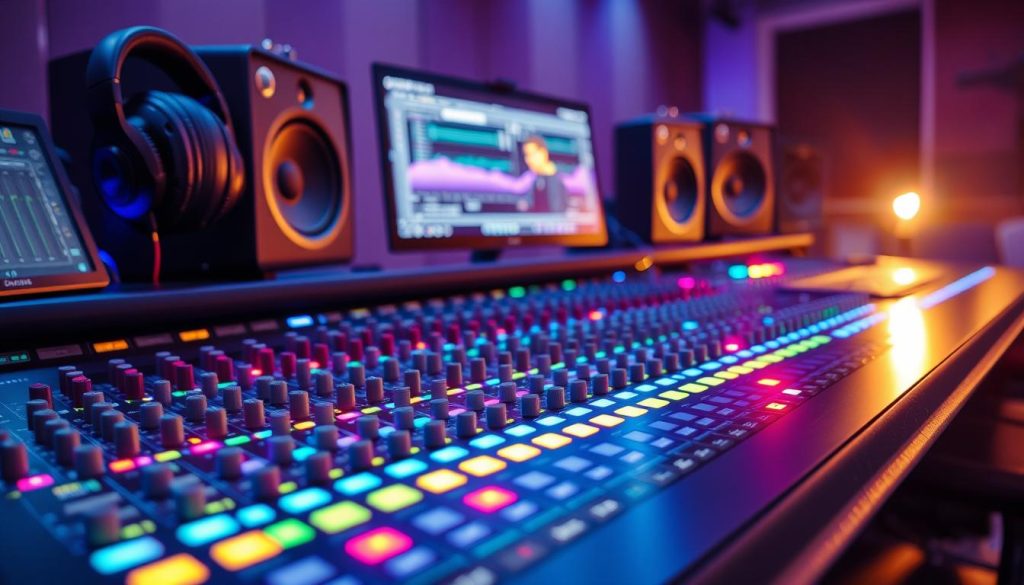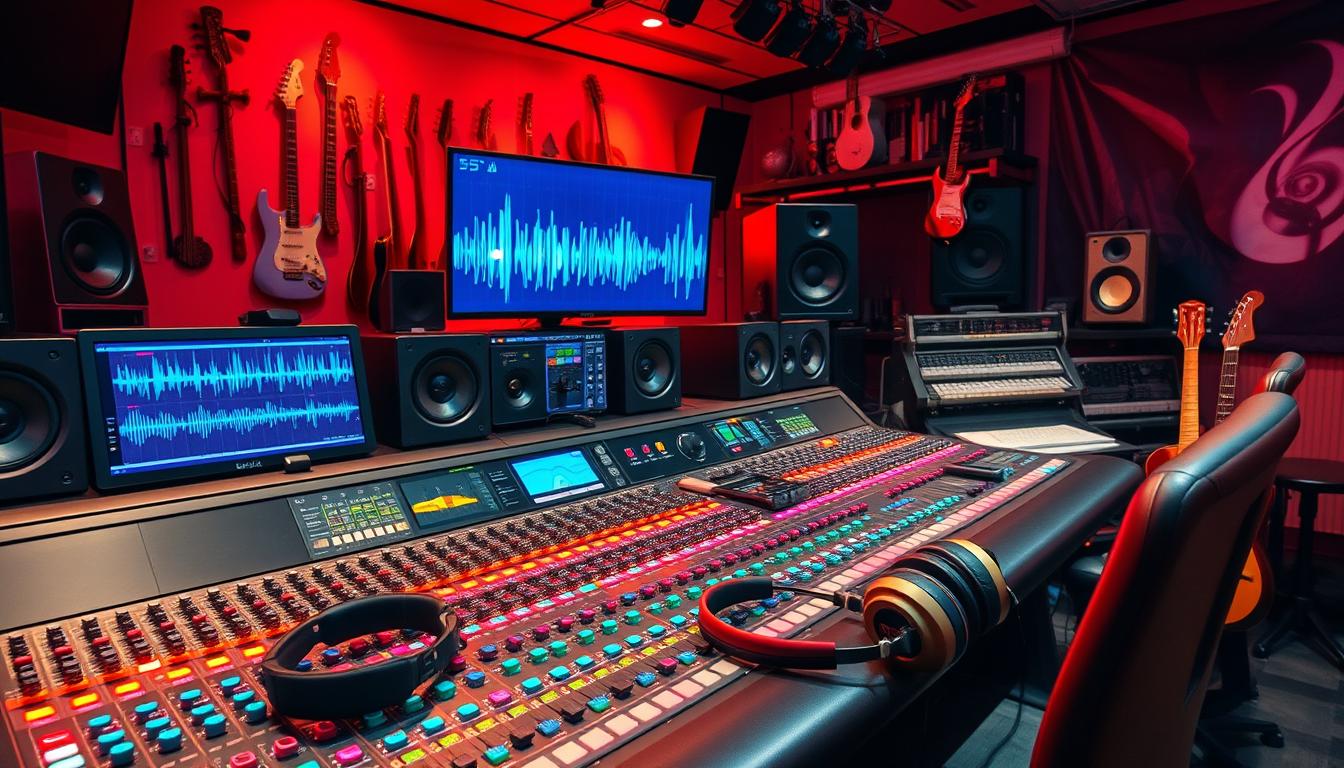I love making music and know how important a great mix is. This guide will share my tips to help you improve your music. I aim to boost your music to new levels.
This guide is for both new and experienced music producers. You’ll learn the basics of mixing music. We’ll cover setting up your space, mixing vs mastering, EQ, compression, and effects. These are key skills for making music that grabs listeners.
Let’s dive into the world of audio mixing together. By the end, you’ll know how to make your music sound amazing. You’ll be able to impress everyone with your skills.
Understanding the Fundamentals of Audio Mixing
Audio mixing is key in music production. It combines many audio tracks into one, making them sound good together. The goal is to balance the sound and make it smooth.
What is Audio Mixing?
It’s the art of mixing different tracks into one. Here, all the sounds like instruments and vocals come together. The mixer works on levels, panning, and adding effects to make the music sound great.
The Difference Between Mixing and Mastering
Mixing and mastering are different but work together in music production. Mixing shapes each track creatively. Mastering makes the final mix ready for release by adjusting levels and adding a polish.
Knowing the difference between mixing and mastering is key. Mastering the basics of mixing lets you control your music’s sound. This way, you can make mixes that show off your music’s best.
Setting Up Your Audio Mixing Environment
Getting great audio mixes is not just about having the right gear. It’s also key to set up your mixing space right. This lets you hear your audio clearly and make smart choices. We’ll look at the must-have equipment and tools for mixing, and why picking the right monitors is important.
Essential Gear for Audio Mixing
You’ll need some important equipment for your mixing setup. First, an audio interface connects your computer to your audio inputs and outputs. Then, you’ll want high-quality studio monitors to listen to your mixes. Don’t forget a reliable pair of headphones for detailed listening. You might also consider a MIDI controller or mixing console for more control.
Choosing the Right Monitoring Equipment
Choosing the right studio monitors and headphones is key. Studio monitors should give you an accurate sound, showing you your audio as it really is. Headphones are great for focusing on certain parts of your mix. But, they shouldn’t be the only thing you rely on, as they can give a different view of your audio.
The mixing environment also matters a lot. Try to set up your space so it doesn’t echo or reflect sound in ways that mess with your hearing. This helps you hear your audio clearly.
With the right audio mixing gear and a good mixing environment, you’re on your way to mastering audio mixing. You’ll get professional-sounding results.
audio mixing guide: Balancing Levels and Panning

Mixing audio well is key for any audio engineer. It’s all about balancing levels and panning. These skills make your mix stand out.
First, let’s talk about balancing levels. Each track in your mix has its own volume. You need to make sure they work together. Adjusting the volume of each track makes a balanced mix. This lets each sound shine without getting too loud.
Then, there’s panning. It lets you place sounds in the stereo field. By panning, you can make your mix feel wider and deeper. This pulls your listeners into the music.
To get good at panning, try different positions for your tracks. Think about how they sound together. Using volume automation can also help. It changes levels during the mix to keep the sound interesting.
Using balancing audio levels, panning, and volume automation makes your mixes better. These are basic audio mixing tips. They help bring out the best in your music.
| Technique | Description | Benefits |
|---|---|---|
| Balancing Audio Levels | Adjusting the volume of individual tracks to create a cohesive and well-balanced mix. | Ensures that each element in the mix has its own distinct place, preventing any one track from dominating or being overpowered. |
| Panning | Positioning the individual tracks within the stereo field to create a sense of depth and space. | Enhances the overall stereo imaging, making the mix feel more immersive and three-dimensional. |
| Volume Automation | Dynamically adjusting the volume of tracks throughout the mix to maintain a consistent balance. | Allows for fine-tuning of the mix, ensuring that the levels remain optimal at all times. |
The Power of Equalization (EQ)

Equalization (EQ) is key in audio mixing. It lets us adjust sound frequencies to make them work well together. By learning EQ, you can fix bad sounds, highlight important parts, and make your mix sound professional.
Using EQ to Shape Sounds
EQ means changing the volume of certain sound frequencies in an audio signal. It’s useful for vocals, instruments, or the whole mix. Knowing about audio EQ and EQ techniques lets you shape your tracks carefully.
Equalization in mixing helps fix bad frequencies. Maybe a vocal sounds too deep or a guitar too sharp. With EQ, you can adjust these to make your mix smooth and balanced.
EQ isn’t just for fixing issues. It’s great for making certain sounds stand out. By boosting key frequencies, your lead vocals or bass can be more noticeable and grab the listener’s attention.
Learning to use mixing with EQ and frequency shaping is key for a pro-sounding mix. With the right skills and an attentive ear, you can use EQ to make your mix really stand out.
Compression: Controlling Dynamic Range
I love using compression in audio mixing. It helps me control the loud and soft parts of my tracks. This makes the sound more even and interesting.
Compression reduces the difference between the loudest and softest parts. This makes the sound more consistent. It’s great for tracks with a lot of volume changes.
When using compression, you need to think about a few things. These include threshold, ratio, attack, and release. These settings help you make the compression right for each track. A high ratio makes the sound more intense, while a slow attack keeps the natural feel.
Compression adds character and control to your tracks. It helps make the mix sound better together. It’s great for controlling loud drums or adding depth to bass.
Try different compression techniques as you mix. With practice, you can make your mixes sound amazing.
Adding Depth with Reverb and Delay Effects
As an audio enthusiast, I’ve found that reverb and delay effects are key. They make your mixes sound bigger and more immersive. These tools can make your listeners feel like they’re right there in the action.
Applying Reverb for a Sense of Space
Reverb helps make your music sound like it’s in a real place, from small studios to huge halls. Adding the right amount of reverb makes your mix sound real and deep. Try adjusting things like decay time and pre-delay to match your music and goals.
Using reverb can make your music feel deep and spread out. Add different amounts of reverb to each instrument or vocal. This makes some sounds close and others far away, creating a cool atmosphere.
Reverb also helps your mix sound connected. It gives your music a common sound that pulls everything together. By blending reverb carefully, you can make your music feel like it’s happening right in front of your listeners.
Fine-Tuning and Finalizing Your Mix
Now, I’m focusing on the final touches of my mix. I aim to make it balanced and polished for the next step. By adjusting levels and fixing any issues, I ensure my mix sounds great on any system.
Keeping a steady workflow is key at this point. I’ll go through each track, making small changes to levels, panning, and effects. This careful approach helps me fix any remaining problems.
Polishing the mix is not just about technical changes. It’s also about making sure everything sounds good together. By fine-tuning, I make sure the mix is balanced and engaging. It’s now ready for mastering.

